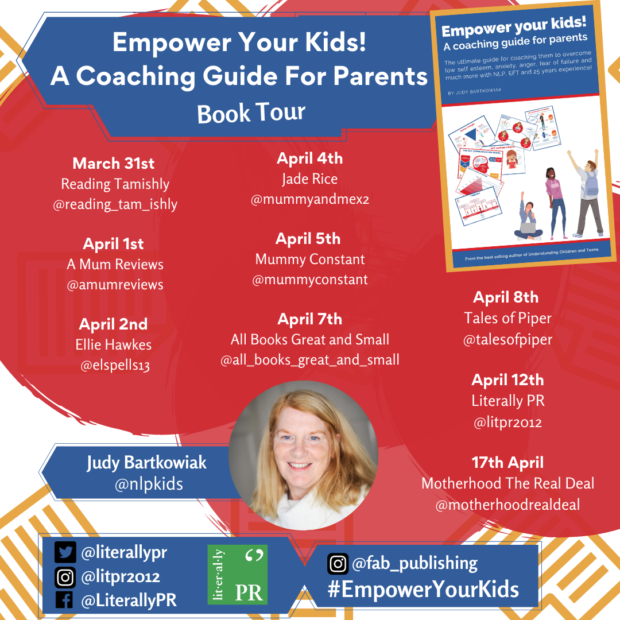How Tapping Can Help Parents Empower their Children

Judy Bartkowiak On Russel Brand’s New Video on Tapping | How Tapping Can Help Parents Empower Their Children + a How to Guide to Tapping With Your Children
Russell Brand starts by asking “Is it possible that new iterations of ancient techniques could be used to get us to new levels of excellence and help us with anxiety and mental health? The tapping technique is one such method, an interesting, innovative and potentially mind-changing technique.
Nick Ortner of The Tapping Solution, explains how the technique has been scientifically proven by identifying how electrical energy focuses on the meridian tapping points and by tapping on these specific points, we can clear negative emotions. But where do these emotions come from and why do we get triggered?
Nick describes how what we have experienced as children can affect us. Say a child gets up to speak in class and everyone laughs. In that moment he might imprint a belief or decision that ‘ speaking in front of people is dangerous’ and clams up in future. Or he might make a belief or decision that it feels good to make people laugh and he wants to do it more often. The same experience can have a different result in different children and can imprint a belief that they will hold onto as their way of protecting themselves.
In Judy Bartkowiak’s new book ‘Empower your kids! A coaching guide for parents’, Judy explains this in more detail so that parents can share the technique with their children to manage the negative emotions that so many are experiencing in lockdown.
“What happens is that our subconscious created a belief about ourselves in the memory and also created an emotion. This happens, especially in the case of negative experiences, as a way to protect you. By allowing you to remember it, we can then hope to avoid repeating it. However, what often happens is because we are on the lookout for it, we inadvertently attract it. Something that would mean nothing to someone else will trigger us into a Fight/Flight/Freeze response. It’s like re-experiencing that early years’ memory every time. The emotion will seem quite child-like as a result. Whenever something happens that triggers that belief, or the memory, we also experience the emotion attached to it, such as fear, hurt or anger, and this sends a signal to our brain that causes an imbalance. We can release this with tapping. As we tap we say the words that relate to the negative emotion.
We can use tapping for any negative emotion and it is very fast and effective for calming children from babies to teenagers. It is also extremely beneficial when we, as parents, tap on ourselves so we can stay calm, resourced and be the best version of ourselves. So, start by having a go yourself. Practise on yourself. Practise on your partner and your friends. One of the best things about this technique is that when you’re helping someone else you don’t even have to know the situation that has triggered them. You can clear the negative emotions without them having to share the back story.

- How to tap with your children
You’ll notice there are tapping points on the body and on the hands. The beauty of EFT, one of many in fact, is that it is really easy to teach children so they can use it themselves whenever they need to, even when we aren’t around. They can therefore use it at school and instead of using the usual body tapping points they can use their hand points under the desk. Many schools have introduced tapping as a way to create a learning state for children at the beginning of a lesson and to ease anxiety and stress before exams or times of difficulty in class.
A lot of children struggle to get to sleep or they wake up at night and can’t get back to sleep. This is an excellent technique to teach them because they can get themselves back to sleep.
The other aspect that makes EFT so great with kids is that we use very few words and those we do use come from them. It’s useful to have a pen and paper to hand to jot their words down because it is important only to use the words they use. This is called ‘Clean Language’ and it means we use exactly what they say throughout the process. We don’t correct or summarise or make any assumptions, the process is ‘clean’ in that we keep ourselves out of it and just follow the process.
I’m going to talk you through the basic process here so you have it to hand but having done it yourself already using my more thorough instructions you’ll be able to make the minor variations needed for different issues mentioned in the chapters in Part 2.
If you have young children you can tap directly on them so they don’t have to think about where to tap themselves. As they become familiar with the points, they can do it for themselves or they might like to tap on their bear or cuddly. This is what we call surrogate tapping because whilst you or your child is tapping on the bear, they’re actually thinking of their own thoughts and projecting them onto their cuddly toy.
We can also do something similar when we tap for our loved ones. We can bring our loved one to mind and imagine we are tapping on them. If we get a really good connection, we can actually ease their stress even though they may not even know we are tapping for them.
For example, if you know your child may be feeling anxious at school, you can imagine you’re tapping on them. Imagine they are standing in front of you and connect to the thoughts and feelings they might be having right now. Then tap on their points as you imagine they are there with you.
When we are physically with someone and tapping with them, for example with your child at bedtime or before school if they’re worried about going, both of you tapping together and your partner as well, and other children, is called borrowing benefits. As you all tap together you create a bigger energy than just one person tapping. That’s why silent tapping in school classrooms, all the children tapping together in silence on whatever is troubling them at that time will have more clearing impact on everyone including the teacher, than them tapping alone.
Tapping along with your child will really help. It’s like doubling the energy! In any case to start with, you will need to lead the tapping and there may be times, depending on the age of your child when they will in any case ask you to tap with them. When you do this, you don’t need to know what they want help with. This is another great benefit of tapping compared to NLP because you can simply tap silently along with them and whatever is going on for them will still clear because that is where they will be focusing even though they don’t have to tell you what it is.”
As Nick Ortner goes on to say in the interview, tapping is usually used in conjunction with other therapies which is why each issue chapter in Part 2 of Judy’s book, combines elements of Neuro Linguistic Programming, Mindfulness and Art as well as providing a selection of tapping scripts for anger, anxiety, coping with change, fear, friendship, learning struggles, low self-esteem and sleep issues. You’ll find more general tapping scripts and scripts for when they don’t know what’s troubling them, in Part 1 along with explanations to help with communicating with your child or teen.
Buy the book: Empower Your Kids! A coaching guide for parents
By Judy Bartkowiak, published by Free Association Books, March 31st 2021, £11.99, 9781911383567
Guest Article.





